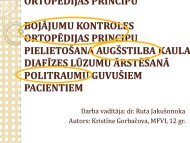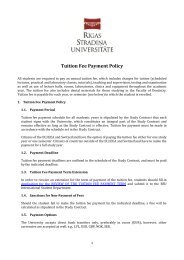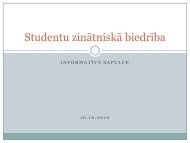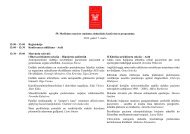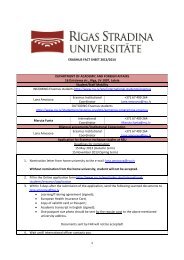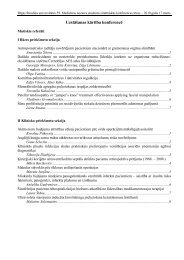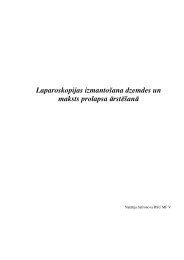History of Latvia: a Brief Survey
History of Latvia: a Brief Survey
History of Latvia: a Brief Survey
- No tags were found...
You also want an ePaper? Increase the reach of your titles
YUMPU automatically turns print PDFs into web optimized ePapers that Google loves.
The Independence Battles. A unit <strong>of</strong>the <strong>Latvia</strong>n National Army in Rīga’s OldTown, autumn 1919.October 1919 Bermont-Avalov’s troops attacked Rīga. The <strong>Latvia</strong>ns thwarted this intrusionon the banks <strong>of</strong> the Daugava River, and by 11 November the Bermontians were driven out <strong>of</strong>Rīga. By the end <strong>of</strong> November they had been expelled from the <strong>Latvia</strong>n territory altogether.At the beginning <strong>of</strong> 1920, Bolshevik armed forces were forced from the area around <strong>Latvia</strong>’seastern border. On 11 August 1920, <strong>Latvia</strong> signed a peace treaty with Soviet Russia, in whichRussia acknowledged <strong>Latvia</strong>’s sovereignty and willingly gave up claims to the <strong>Latvia</strong>n territoryfor all time. Soviet Russia was the first to recognise <strong>Latvia</strong>’s independence. However, futureactions proved that these had been empty promises.Peace, for which <strong>Latvia</strong> had waited so long, had finally arrived, and the work <strong>of</strong> building anew nation could begin. Deeply disillusioned by the Bolshevik totalitarian regime, <strong>Latvia</strong>nrefugees who had fled to Russia during the First World War continued to return to <strong>Latvia</strong> until1927. Repatriates included <strong>Latvia</strong>n Riflemen and former opponents <strong>of</strong> <strong>Latvia</strong>n independence— more than 200,000 people overall.On 26 January 1921, the victors <strong>of</strong> the First World War (Great Britain, France, Italy and Japan,collectively known as the Allies) <strong>of</strong>ficially recognised <strong>Latvia</strong>’s independence. This was alsoa signal to other countries to recognise <strong>Latvia</strong>’s sovereignty. On 22 September 1921, <strong>Latvia</strong>and the other two Baltic countries were admitted to the most prominent internationalorganisation <strong>of</strong> that time — the League <strong>of</strong> Nations. In the period between the world wars<strong>Latvia</strong> endeavoured to pursue a neutral foreign policy which was oriented toward closemutual co-operation between the Baltic countries and the League <strong>of</strong> Nations.The Lāčplēsis Military Order(established in 1919) is the first andhighest military award in the Republic<strong>of</strong> <strong>Latvia</strong>. The military award wasconferred on soldiers <strong>of</strong> <strong>Latvia</strong>’s Armyand the former <strong>Latvia</strong>n RiflemenRegiments for merit in military actionas well as on foreigners who hadtaken part in the struggle for theliberation <strong>of</strong> <strong>Latvia</strong> or given other type<strong>of</strong> contribution to the founding anddevelopment <strong>of</strong> the state <strong>of</strong> <strong>Latvia</strong>. Overnine years (since 1919) 2146 LāčplēsisMilitary Orders <strong>of</strong> all three classes wereawarded.27



